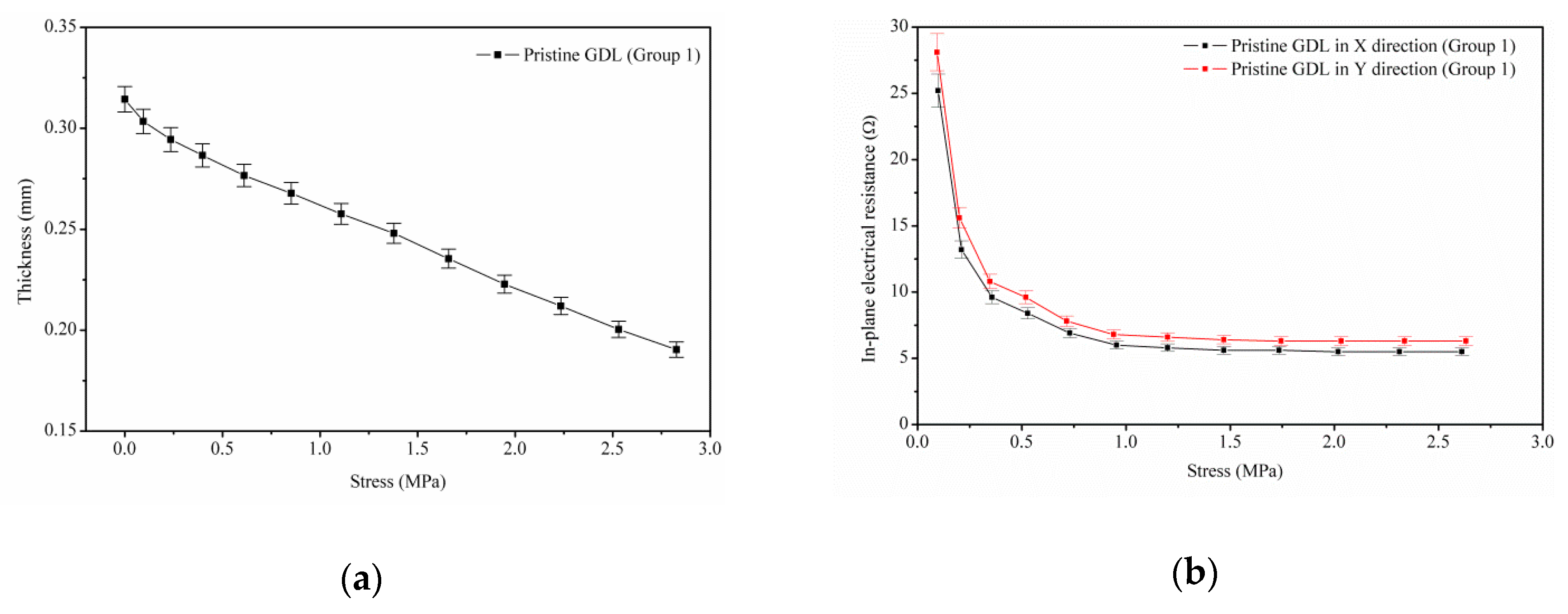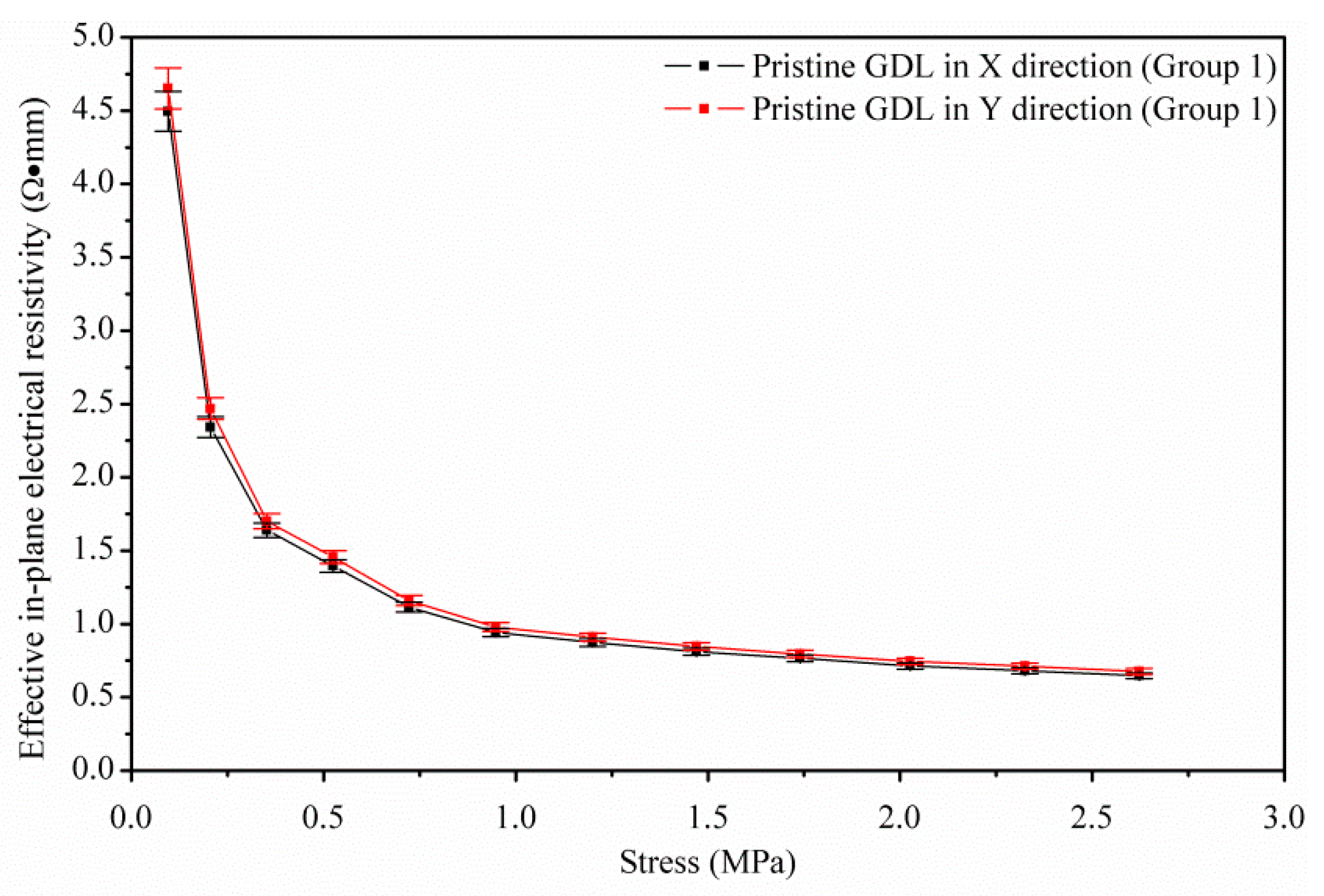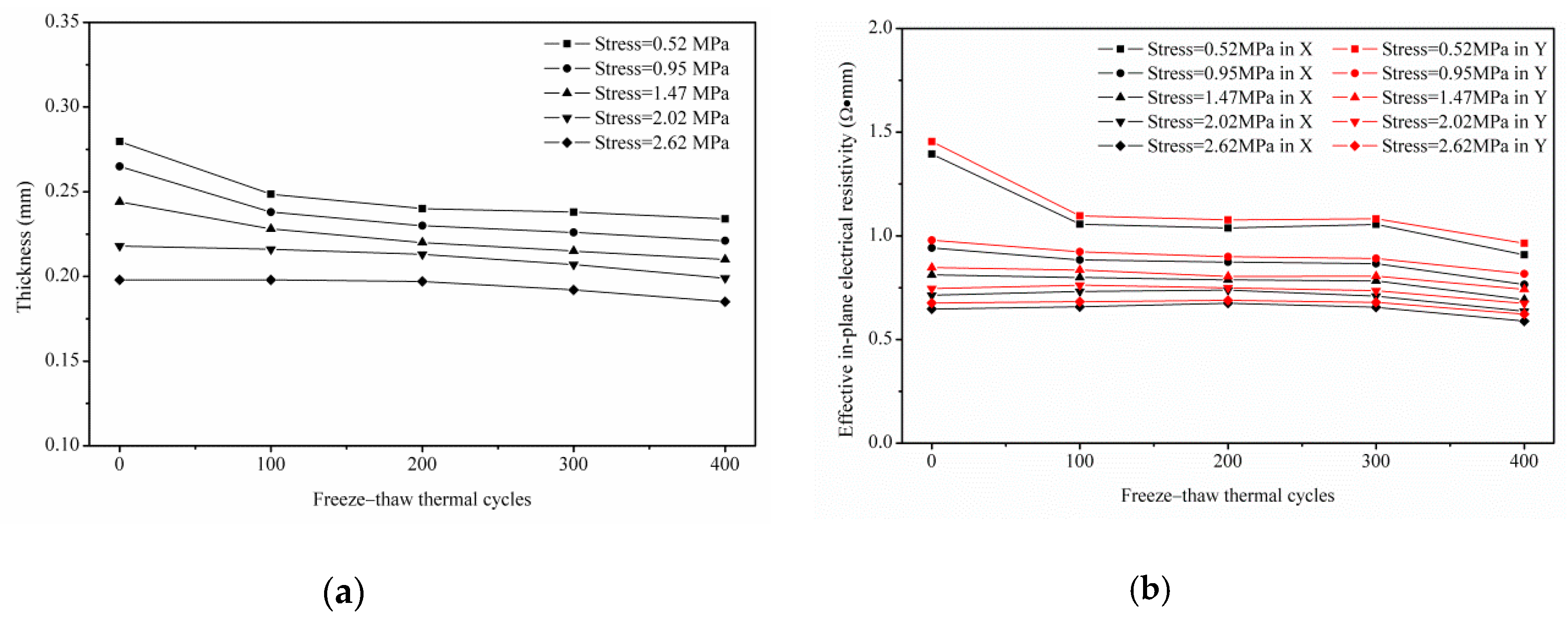Characterization of Effective In-Plane Electrical Resistivity of a Gas Diffusion Layer in Polymer Electrolyte Membrane Fuel Cells through Freeze–Thaw Thermal Cycles
Abstract
1. Introduction
2. Experimental Sections
2.1. Material
2.2. Freeze–Thaw Thermal Treatment
2.3. Test Methods
3. Results and Discussion
3.1. Effective In-Plane Electrical Resistivity of Pristine GDLs
3.2. Effective In-Plane Electrical Resistivity of Aged GDLs
4. Conclusions
Author Contributions
Funding
Acknowledgments
Conflicts of Interest
References
- Wei, H.; Cui, D.; Ma, J.; Chu, L.; Zhao, X.; Song, H.; Liu, H.; Liu, T.; Wang, N.; Guo, Z. Energy conversion technologies towards self-powered electrochemical energy storage systems: The state of the art and perspectives. J. Mater. Chem. A 2017, 5, 1873–1894. [Google Scholar] [CrossRef]
- Luo, B.; Ye, D.; Wang, L. Recent progress on integrated energy conversion and storage systems. Adv. Sci. 2017, 4, 1700104. [Google Scholar] [CrossRef] [PubMed]
- Zhao, X.; Yang, Y.; Wu, J.; Tan, Y.; Liu, Y.; Kong, L.; Kang, L.; Ran, F. A polymer-supported electrolyte-affinity hybrid membrane and modification of the amphiphilic block copolymer for use as a super-high flexible and high-performance supercapacitor. Sustain. Energy Fuels 2017, 1, 1074–1081. [Google Scholar] [CrossRef]
- Piana, G.; Bella, F.; Geobaldo, F.; Meligrana, G.; Gerbaldi, C. PEO/LAGP hybrid solid polymer electrolytes for ambient temperature lithium batteries by solvent-free, “one pot” preparation. J. Energy Storage 2019, 26, 100947. [Google Scholar] [CrossRef]
- Falco, M.; Castro, L.; Nair, J.R.; Bella, F.; Bardé, F.; Meligrana, G.; Gerbaldi, C. Uv-cross-linked composite polymer electrolyte for high-rate, ambient temperature lithium batteries. ACS Appl. Energy Mater. 2019, 2, 1600–1607. [Google Scholar] [CrossRef]
- Falco, M.; Simari, C.; Ferrara, C.; Nair, J.R.; Meligrana, G.; Bella, F.; Nicotera, I.; Mustarelli, P.; Winter, M.; Gerbaldi, C. Understanding the effect of uv-induced cross-linking on the physico-chemical properties of highly performing peo/litfsi-based polymer electrolytes. Langmuir 2019, 35, 8210–8219. [Google Scholar]
- Inci, M.; Türksoy, Ö. Review of fuel cells to grid interface: Configurations, technical challenges and trends. J. Clean. Prod. 2019, 213, 1353–1370. [Google Scholar] [CrossRef]
- Stamatakis, E.; Yiotis, A.; Giannissi, S.; Tolias, I.; Stubos, A. Modeling and simulation supporting the application of fuel cell & hydrogen technologies. J. Comput. Sci. 2018, 27, 10–20. [Google Scholar]
- Hart, D.; Lewis, J.; Lehner, F.; Klippenstein, M.; Rose, R. The Fuel Cell Industry Review 2017. e4tech. Available online: http://www.fuelcellindustryreview.com/archive/TheFuelCellIndustryReview2017.pdf (accessed on 22 November 2019).
- Dafalla, A.M.; Jiang, F. Stresses and their impacts on proton exchange membrane fuel cells: A review. Int. J. Hydrogen Energy 2018, 43, 2327–2348. [Google Scholar] [CrossRef]
- Vikram, A.; Chowdhury, P.R.; Phillips, R.K.; Hoorfar, M. Measurement of effective bulk and contact resistance of gas diffusion layer under inhomogeneous compression—Part I: Electrical conductivity. J. Power Sources 2016, 320, 274–285. [Google Scholar] [CrossRef]
- Todd, D.; Bennett, S.; Mérida, W. Anisotropic electrical resistance of proton exchange membrane fuel cell transport layers as a function of cyclic strain. Int. J. Hydrogen Energy 2016, 41, 6029–6035. [Google Scholar] [CrossRef]
- El Oualid, S.; Lachat, R.; Candusso, D.; Meyer, Y. Characterization process to measure the electrical contact resistance of gas diffusion layers under mechanical static compressive loads. Int. J. Hydrogen Energy 2017, 42, 23920–23931. [Google Scholar] [CrossRef]
- Zhou, T.; Liu, H. Effects of the electrical resistances of the gdl in a pem fuel cell. J. Power Sources 2006, 161, 444–453. [Google Scholar] [CrossRef]
- Tanaka, S.; Shudo, T. Experimental and numerical modeling study of the electrical resistance of gas diffusion layer-less polymer electrolyte membrane fuel cells. J. Power Sources 2015, 278, 382–395. [Google Scholar] [CrossRef]
- Bapat, C.; Thynell, S. Effect of anisotropic electrical resistivity of gas diffusion layers (gdls) on current density and temperature distribution in a polymer electrolyte membrane (pem) fuel cell. J. Power Sources 2008, 185, 428–432. [Google Scholar] [CrossRef]
- Todd, D.; Schwager, M.; Mérida, W. Three-dimensional anisotropic electrical resistivity of pem fuel cell transport layers as functions of compressive strain. J. Electrochem. Soc. 2015, 162, F265–F272. [Google Scholar] [CrossRef][Green Version]
- Aydin, Ö.; Zedda, M.; Zamel, N. Challenges associated with measuring the intrinsic electrical conductivity of carbon paper diffusion media. Fuel Cells 2015, 15, 537–544. [Google Scholar] [CrossRef]
- Morris, D.R.; Gostick, J.T. Determination of the in-plane components of the electrical conductivity tensor in pem fuel cell gas diffusion layers. Electrochim. Acta 2012, 85, 665–673. [Google Scholar] [CrossRef][Green Version]
- Ismail, M.; Damjanovic, T.; Ingham, D.B.; Pourkashanian, M.; Westwood, A. Effect of polytetrafluoroethylene-treatment and microporous layer-coating on the electrical conductivity of gas diffusion layers used in proton exchange membrane fuel cells. J. Power Sources 2010, 195, 2700–2708. [Google Scholar] [CrossRef]
- Ismail, M.; Hughes, K.; Ingham, D.B.; Ma, L.; Pourkashanian, M. Effects of anisotropic permeability and electrical conductivity of gas diffusion layers on the performance of proton exchange membrane fuel cells. Appl. Energy 2012, 95, 50–63. [Google Scholar] [CrossRef]
- Cai, J.; Wei, W.; Hu, X.; Wood, D.A. Electrical conductivity models in saturated porous media: A review. Earth-Sci. Rev. 2017, 171, 419–433. [Google Scholar] [CrossRef]
- Omrani, R.; Shabani, B. Gas diffusion layers in fuel cells and electrolysers: A novel semi-empirical model to predict electrical conductivity of sintered metal fibres. Energies 2019, 12, 855. [Google Scholar] [CrossRef]
- Sadeghifar, H. In-plane and through-plane electrical conductivities and contact resistances of a mercedes-benz catalyst-coated membrane, gas diffusion and micro-porous layers and a ballard graphite bipolar plate: Impact of humidity, compressive load and polytetrafluoroethylene. Energy Convers. Manag. 2017, 154, 191–202. [Google Scholar]
- Zamel, N.; Li, X.; Shen, J. Numerical estimation of the effective electrical conductivity in carbon paper diffusion media. Appl. Energy 2012, 93, 39–44. [Google Scholar] [CrossRef]
- Kim, H.; Lee, Y.-J.; Lee, S.-J.; Chung, Y.-S.; Yoo, Y. Fabrication of carbon papers using polyacrylonitrile fibers as a binder. J. Mater. Sci. 2014, 49, 3831–3838. [Google Scholar] [CrossRef]
- Williams, M.V.; Begg, E.; Bonville, L.; Kunz, H.R.; Fenton, J.M. Characterization of gas diffusion layers for pemfc. J. Electrochem. Soc. 2004, 151, A1173–A1180. [Google Scholar] [CrossRef]
- Sadeghifar, H.; Djilali, N.; Bahrami, M. Counter-intuitive reduction of thermal contact resistance with porosity: A case study of polymer electrolyte membrane fuel cells. Int. J. Hydrogen Energy 2016, 41, 6833–6841. [Google Scholar] [CrossRef]
- Su, H.; Sita, C.; Pasupathi, S. The effect of gas diffusion layer ptfe content on the performance of high temperature proton exchange membrane fuel cell. Int. J. Electrochem. Sci. 2016, 11, 2919–2926. [Google Scholar] [CrossRef]
- Lobato, J.; Canizares, P.; Rodrigo, M.; Ruiz-López, C.; Linares, J. Influence of the teflon loading in the gas diffusion layer of pbi-based pem fuel cells. J. Appl. Electrochem. 2008, 38, 793–802. [Google Scholar] [CrossRef]
- Ye, D.; Gauthier, E.; Benziger, J.B.; Pan, M. Bulk and contact resistances of gas diffusion layers in proton exchange membrane fuel cells. J. Power Sources 2014, 256, 449–456. [Google Scholar] [CrossRef]
- Rohendi, D.; Majlan, E.H.; Mohamad, A.B.; Daud, W.R.W.; Kadhum, A.A.H.; Shyuan, L.K. Effect of ptfe content and sintering temperature on the properties of a fuel cell electrode backing layer. J. Fuel Cell Sci. Technol. 2014, 11, 041003. [Google Scholar] [CrossRef]
- Hamour, M.; Grandidier, J.; Ouibrahim, A.; Martemianov, S. Electrical conductivity of pemfc under loading. J. Power Sources 2015, 289, 160–167. [Google Scholar] [CrossRef]
- Parikh, N.; Allen, J.; Yassar, R.S. Effect of deformation on electrical properties of carbon fibers used in gas diffusion layer of proton exchange membrane fuel cells. J. Power Sources 2009, 193, 766–768. [Google Scholar] [CrossRef]
- Tanaka, S.; Bradfield, W.W.; Legrand, C.; Malan, A.G. Numerical and experimental study of the effects of the electrical resistance and diffusivity under clamping pressure on the performance of a metallic gas-diffusion layer in polymer electrolyte fuel cells. J. Power Sources 2016, 330, 273–284. [Google Scholar] [CrossRef]
- Kleemann, J.; Finsterwalder, F.; Tillmetz, W. Characterisation of mechanical behaviour and coupled electrical properties of polymer electrolyte membrane fuel cell gas diffusion layers. J. Power Sources 2009, 190, 92–102. [Google Scholar] [CrossRef]
- Lee, J.; Chevalier, S.; Banerjee, R.; Antonacci, P.; Ge, N.; Yip, R.; Kotaka, T.; Tabuchi, Y.; Bazylak, A. Investigating the effects of gas diffusion layer substrate thickness on polymer electrolyte membrane fuel cell performance via synchrotron x-ray radiography. Electrochim. Acta 2017, 236, 161–170. [Google Scholar] [CrossRef]
- Abderezzak, B. Introduction to Transfer Phenomena in Pem Fuel Cells, 1st ed.; ISTE Press-Elsevier: London, UK, 2019; pp. 132–144. [Google Scholar]
- Matboo Ghorbani, M.; Taherian, R. Methods of measuring electrical properties of material. In Electrical Conductivity in Polymer-Bansed Composites: Experiments, Modelling and Applications, 1st ed.; Taherian, R., Kausar, A., Eds.; William Andrew: New York, NY, USA, 2018; pp. 365–394. [Google Scholar]
- Sadeghifar, H.; Djilali, N.; Bahrami, M. Effect of polytetrafluoroethylene (ptfe) and micro porous layer (mpl) on thermal conductivity of fuel cell gas diffusion layers: Modeling and experiments. J. Power Sources 2014, 248, 632–641. [Google Scholar] [CrossRef]
- Chen, Y.; Jiang, C.; Cho, C. Effects of freeze⁻thaw thermal cycles on the mechanical degradation of the gas diffusion layer in polymer electrolyte membrane fuel cells. Polymers 2019, 11, 428. [Google Scholar] [CrossRef]
- Philips’Gloeilampenfabrieken, O. A method of measuring specific resistivity and hall effect of discs of arbitrary shape. Philips Res. Rep. 1958, 13, 1–9. [Google Scholar]
- Montgomery, H.C. Method for measuring electrical resistivity of anisotropic materials. J. Appl. Phys. 1971, 42, 2971–2975. [Google Scholar] [CrossRef]
- Jayakumar, A.; Singamneni, S.; Ramos, M.; Al-Jumaily, A.M.; Pethaiah, S.S. Manufacturing the gas diffusion layer for pem fuel cell using a novel 3D printing technique and critical assessment of the challenges encountered. Materials 2017, 10, 796. [Google Scholar] [CrossRef]
- Murthy, M. Proton Conducting Membrane Fuel Cells III: Proceedings of the International Symposium; The Electrochemical Society: Pennington, NJ, USA, 2005; pp. 270–286. [Google Scholar]
- Li, M.-Y.; Yang, M.; Vargas, E.; Neff, K.; Vanli, A.; Liang, R. Analysis of variance on thickness and electrical conductivity measurements of carbon nanotube thin films. Meas. Sci. Technol. 2016, 27, 095004. [Google Scholar] [CrossRef]
- Qiu, D.; Yi, P.; Peng, L.; Lai, X. Study on shape error effect of metallic bipolar plate on the gdl contact pressure distribution in proton exchange membrane fuel cell. Int. J. Hydrogen Energy 2013, 38, 6762–6772. [Google Scholar] [CrossRef]
- Smits, F. Measurement of sheet resistivities with the four-point probe. Bell Syst. Tech. J. 1958, 37, 711–718. [Google Scholar] [CrossRef]
- dos Santos, C.; de Campos, A.; da Luz, M.S.; White, B.D.; Neumeier, J.J.; de Lima, B.S.; Shigue, C.Y. Procedure for measuring electrical resistivity of anisotropic materials: A revision of the montgomery method. J. Appl. Phys. 2011, 110, 083703. [Google Scholar] [CrossRef]
- Wasscher, J. Note on four-point resistivity measurements on anisotropic conductors. Philips Res. Rep. 1961, 16, 301–306. [Google Scholar]
- Vielstich, W.; Lamm, A.; Gasteiger, H.A. Handbook of Fuel Cells: Fundamentals Technology and Applications; John Wiley & Sons: New York, NY, USA, 2003; Volume 3, pp. 517–537. [Google Scholar]
- Sadeghifar, H.; Djilali, N.; Bahrami, M. A new model for thermal contact resistance between fuel cell gas diffusion layers and bipolar plates. J. Power Sources 2014, 266, 51–59. [Google Scholar] [CrossRef]
- Sadeghifar, H.; Bahrami, M.; Djilali, N. A statistically-based thermal conductivity model for fuel cell gas diffusion layers. J. Power Sources 2013, 233, 369–379. [Google Scholar] [CrossRef]
- Carral, C.; Mélé, P. A constitutive law to predict the compression of gas diffusion layers. Int. J. Hydrogen Energy 2018, 43, 19721–19729. [Google Scholar] [CrossRef]
- Movahedi, M.; Ramiar, A.; Ranjber, A. 3D numerical investigation of clamping pressure effect on the performance of proton exchange membrane fuel cell with interdigitated flow field. Energy 2018, 142, 617–632. [Google Scholar] [CrossRef]
- He, S.; Kim, S.H.; Mench, M.M. 1D transient model for frost heave in polymer electrolyte fuel cells II. Parametric study. J. Electrochem. Soc. 2007, 154, B1024–B1033. [Google Scholar] [CrossRef]









© 2019 by the authors. Licensee MDPI, Basel, Switzerland. This article is an open access article distributed under the terms and conditions of the Creative Commons Attribution (CC BY) license (http://creativecommons.org/licenses/by/4.0/).
Share and Cite
Chen, Y.; Jiang, C.; Cho, C. Characterization of Effective In-Plane Electrical Resistivity of a Gas Diffusion Layer in Polymer Electrolyte Membrane Fuel Cells through Freeze–Thaw Thermal Cycles. Energies 2020, 13, 145. https://doi.org/10.3390/en13010145
Chen Y, Jiang C, Cho C. Characterization of Effective In-Plane Electrical Resistivity of a Gas Diffusion Layer in Polymer Electrolyte Membrane Fuel Cells through Freeze–Thaw Thermal Cycles. Energies. 2020; 13(1):145. https://doi.org/10.3390/en13010145
Chicago/Turabian StyleChen, Yanqin, Chao Jiang, and Chongdu Cho. 2020. "Characterization of Effective In-Plane Electrical Resistivity of a Gas Diffusion Layer in Polymer Electrolyte Membrane Fuel Cells through Freeze–Thaw Thermal Cycles" Energies 13, no. 1: 145. https://doi.org/10.3390/en13010145
APA StyleChen, Y., Jiang, C., & Cho, C. (2020). Characterization of Effective In-Plane Electrical Resistivity of a Gas Diffusion Layer in Polymer Electrolyte Membrane Fuel Cells through Freeze–Thaw Thermal Cycles. Energies, 13(1), 145. https://doi.org/10.3390/en13010145





